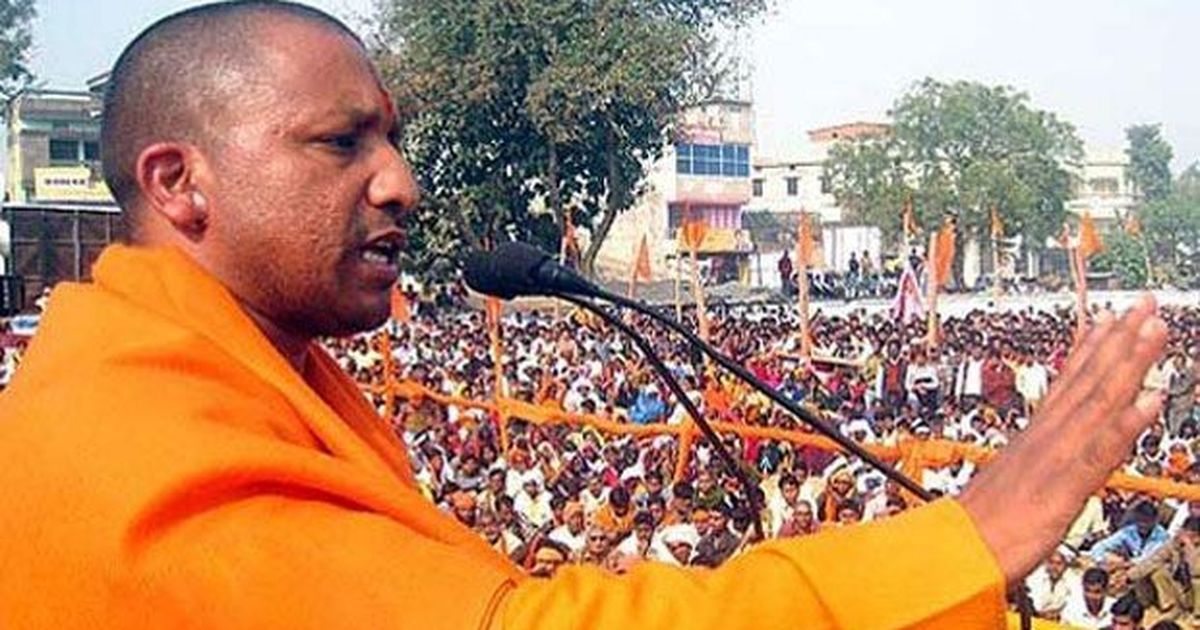The BJP leader and his Hindu Yuva Vahini face multiple cases for creating communal tension in the state.

Image: PTI
On the way, however, they fired at a group of Samajwadi Party workers who had gathered on the main road close to the village for a routine demonstration against the then BJP government in the state. In the attack, at least four persons were injured. One of them, Head Constable Satyaprakash Yadav, who was the personal security guard of the Samajwadi Party leader leading the demonstration, Talat Aziz, later succumbed to bullet injuries.
A first information report filed by the police that same evening at the Kotwali thana in Maharajganj turned out to be the first in a series of such legal entries triggered by incidents involving Adityanath, directly or indirectly, in the years that followed. Many of these FIRs against Adityanath, now the chief minister of the recently formed BJP government in Uttar Pradesh, are still being investigated by the Crime Branch-Crime Investigation Department, the investigation and intelligence wing of the state police.
The FIR in the Panchrukhiya case names Adityanath and “24 other identified persons” for attempt to murder, rioting, carrying deadly weapons, defiling a place of worship, trespassing on a Muslim graveyard, and promoting enmity between two religious groups.
The case was significant partly because it was the first clear hint of the extent to which Adityanath was ready to go to manufacture a riot, and partly because the revelation came merely a year after he joined active politics, becoming a member of Parliament for the first time from the state’s Gorakhpur seat in 1998.
Riot record
For some time after he was named in the FIR, the Gorakhpur MP lay low. But once he formed his personal anti-minority outfit, the Hindu Yuva Vahini, in 2002, within weeks of the Godhra incident in Gujarat that year – when the death of 59 kar sevaks in a fire on the Sabarmati Express set off Hindu-Muslim riots that killed over 2,000 people in Gujarat – the outburst of communal riots became unusually frequent in Gorakhpur and its neighbourhood.
The region witnessed at least six major riots in the very first year since the group’s formation – at Mohan Mundera village in Kushinagar district, Nathua village in Gorakhpur district, and Turkmanpur locality in Gorakhpur city in June, at Narkataha village in Maharajganj in August, and at Bhedahi village in Maharajganj, and the Dhanghata locality of Sant Kabirnagar in September.
Most of these cases started off as criminal incidents that turned communal after Adityanath or other leaders of the Hindu Yuva Vahini jumped in. In all, between 2002 and 2007, when Adityanath was arrested and kept in lock-up, Gorakhpur and its neighbouring districts witnessed at least 22 major riots, most involving him or his henchmen.
These arrests, in fact, were the only time the police showed some spine in dealing with him and his outfit. The crackdown was in response to Hindu-Muslim riots that had erupted in and around Gorakhpur, caused primarily by a toxic campaign of communal politics by Adityanath and his group in the run-up to the Assembly elections in 2007. Two persons were killed, property worth crores was burnt, and the area remained under curfew for several days during that January-February period.
Adityanath and over a dozen leaders of the Hindu Yuva Vahini were arrested while they were marching towards the troubled areas of Gorakhpur on January 28, 2007, a day after he made an inflammatory speech aimed at turning a small criminal incident into a communal riot. The arrest was timed so as to prevent the group from carrying out its threat of burning the tazia – a replica of Imam Husain’s mausoleum in Iraq – that Muslim residents were to take out as part of a Muharram procession on January 29. Adityanath remained in lock-up till February 7, when he managed to get bail.
The arrest so unnerved Adityanath that on March 12, he broke down, his eyes welling up, on the floor of the Lok Sabha as he explained to Speaker Somnath Chatterjee what he called a “political conspiracy” to kill him.
Rabble rouser to chief minister
The shock apparently turned Adityanath wiser – or more political – as he refrained from personally leading mobs and participating in attacks on Muslims in the manner he used to earlier. He has since restricted himself to making inflammatory speeches and participating in token action, while letting his Hindu Yuva Vahini do the rest.
Most of the FIRs against him from that time are still alive, though their fate has become uncertain now that Adityanath has assumed power in the state. From the chief minister’s office, he can do a modest amount of good, and he can also do immense harm.
This article was first published on Scroll.in